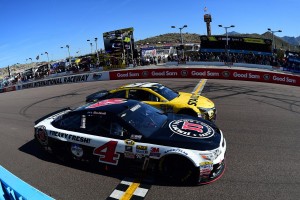
Hope everyone had an Easter that was filled with family gatherings, a few egg hunts, and praising the real reason for the holiday. Now that the holiday is passed, the NASCAR season is set to continue beginning next week with a trip to Martinsville, the first short track on the schedule.
But the first off-weekend for the sport this season comes at a time where the action has been better to start a year than ever anticipated.
As I have made clear since the year started, NASCAR introduced a new aerodynamic package that was ran a couple of times a season ago with great results and praise. The real test would come at the start of this year as four of the first five races would utilize the package, and each track was unique in how it would feel. From old asphalt to smooth surfaces, high banking to progressive corners, and flat tracks to multiple lanes, each was unique.
It has produced excellent racing on each track, and not one driver has complained about it. The fans certainly haven’t a reason to complain either.
In five races, there have been two photo finishes, increased passing, more driver emphasis and tire wear has gone up because of the softer compound. This is exactly what this package was meant to do, and it’s gone beyond what has been expected in the initial test runs a year ago at Kentucky and Darlington.
Here’s the other major statistic: multiple winners.
For the third straight year, the Chase has entered the Easter break with at least 25 percent of the field theoretically filled. Denny Hamlin, Jimmie Johnson, Brad Keselowski and Kevin Harvick are locked into the Chase, so long as they are able to maintain in the top-30 of the standings. Over the last few years with the new Chase setup, combined only nine spots were filled with drivers that failed to win a race entering the 10-race championship run. That shows how many teams have been competitive each year, and how much winning now means for a championship.
The next break in the season is not for a few months, so the potential to fill at least half the Chase is there, although it is unlikely because of how many multi-car teams are showing how strong they are.
At the same time, not all the changes have been widely accepted. What I’m talking about is the new charter system for the sport, reducing the starting field from 43 cars down to 40, but also guaranteeing 36 cars a spot in the field with four “open positions” to the fastest that are not a chartered team.
It’s hard to enforce that rule when with the exception of one race, the line-up for each week has been less than the 40 allotted starting spots.
It was done to save teams money, but at the same time created controversy right away. The Wood Brothers, who were a part-time team for most of the last half-decade, went full-time this season but were not guaranteed a charter. The reason, they did not compete in a full season for so many years. The team was upset they weren’t guaranteed a spot, and would have to race their way in each week to make the field.
However, when there is a field of exactly 40 cars, or less as that has been the case, they are going to be racing for sure. At the same time, one bad qualifying run with a field of 41 cars means rookie Ryan Blaney could be sitting out a race, which would be a major hiccup in his quest for Rookie of the Year.
Whether this is good or bad for the sport is yet to be seen, because it’s the first time something like this has been used. One cannot make that determination from just a few races.
It’s back to action next week, and if the first five races are any indication, this is certainly going to be one season to remember.